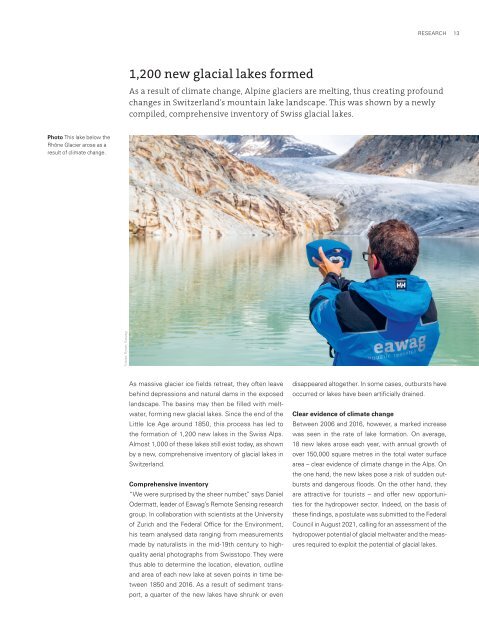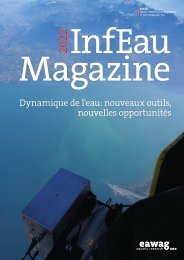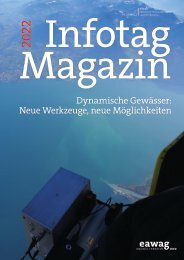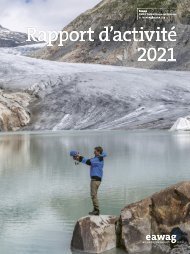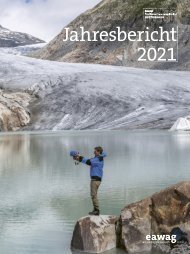Eawag Annual Report 2021
The Annual Report gives a wide-ranging account of current Eawag projects. It is published in English and German, and since 2013 also in French.
The Annual Report gives a wide-ranging account of current Eawag projects. It is published in English and German, and since 2013 also in French.
Create successful ePaper yourself
Turn your PDF publications into a flip-book with our unique Google optimized e-Paper software.
RESEARCH<br />
13<br />
1,200 new glacial lakes formed<br />
As a result of climate change, Alpine glaciers are melting, thus creating profound<br />
changes in Switzerland’s mountain lake landscape. This was shown by a newly<br />
compiled, comprehensive inventory of Swiss glacial lakes.<br />
Photo This lake below the<br />
Rhône Glacier arose as a<br />
result of climate change.<br />
Tobias Ryser, <strong>Eawag</strong><br />
As massive glacier ice fields retreat, they often leave<br />
behind depressions and natural dams in the exposed<br />
landscape. The basins may then be filled with meltwater,<br />
forming new glacial lakes. Since the end of the<br />
Little Ice Age around 1850, this process has led to<br />
the formation of 1,200 new lakes in the Swiss Alps.<br />
Almost 1,000 of these lakes still exist today, as shown<br />
by a new, comprehensive inventory of glacial lakes in<br />
Switzerland.<br />
Comprehensive inventory<br />
“We were surprised by the sheer number,” says Daniel<br />
Odermatt, leader of <strong>Eawag</strong>’s Remote Sensing research<br />
group. In collaboration with scientists at the University<br />
of Zurich and the Federal Office for the Environment,<br />
his team analysed data ranging from measurements<br />
made by naturalists in the mid-19th century to highquality<br />
aerial photographs from Swisstopo. They were<br />
thus able to determine the location, elevation, outline<br />
and area of each new lake at seven points in time between<br />
1850 and 2016. As a result of sediment transport,<br />
a quarter of the new lakes have shrunk or even<br />
disappeared altogether. In some cases, outbursts have<br />
occurred or lakes have been artificially drained.<br />
Clear evidence of climate change<br />
Between 2006 and 2016, however, a marked increase<br />
was seen in the rate of lake formation. On average,<br />
18 new lakes arose each year, with annual growth of<br />
over 150,000 square metres in the total water surface<br />
area – clear evidence of climate change in the Alps. On<br />
the one hand, the new lakes pose a risk of sudden outbursts<br />
and dangerous floods. On the other hand, they<br />
are attractive for tourists – and offer new opportunities<br />
for the hydropower sector. Indeed, on the basis of<br />
these findings, a postulate was submitted to the Federal<br />
Council in August <strong>2021</strong>, calling for an assessment of the<br />
hydropower potential of glacial meltwater and the measures<br />
required to exploit the potential of glacial lakes.


